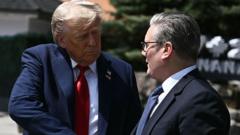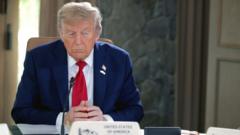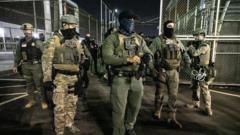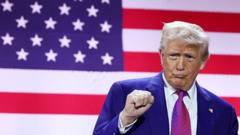The newly signed tariff agreement between the US and the UK features reduced tariffs on car imports but retains tariffs on steel products, creating a mixed response. British Prime Minister Sir Keir Starmer has praised the agreement, but critics point out its limitations.
Trump Advances UK-US Tariff Agreement Amid Mixed Reactions

Trump Advances UK-US Tariff Agreement Amid Mixed Reactions
President Trump has signed an executive order reducing tariffs on UK cars while certain steel tariffs remain, sparking a variety of responses from political leaders and business sectors.
President Donald Trump has taken a significant step in US-UK trade relations by signing an executive order aimed at lowering tariffs on cars imported from the UK. This move formalizes parts of a tariff agreement that was reached during discussions last month, signaling progress amid a backdrop of challenging trade environments.
During the G7 summit in Canada, UK Prime Minister Sir Keir Starmer highlighted the signing as "very important" for both nations involved. The UK government hopes this effort will protect British businesses, especially in the automotive sector, from the adverse consequences of tariffs imposed by Trump earlier this year. Although the agreement reduces the import tariff on certain UK cars to 10% from 25%, it still imposes a levy on a wider range of UK goods, including steel products, which remain uncertain in terms of future tariff reductions.
This agreement stands as the first significant announcement from the White House since the initiation of broad tariffs on goods entering the US earlier this year. The arrangement is particularly crucial for UK manufacturers who depend heavily on exports to the US market. The deal encompasses provisions to allow up to 100,000 cars to enter the US at a 10% tariff, alongside discussions of potential adjustments to steel and aluminum tariffs.
In light of the announcement, Mike Hawes, the head of the Society of Motor Manufacturers and Traders, stated that manufacturers will now be able to proceed with their deliveries, underscoring the necessity of swift governmental action on tariff policies. The deal also promises the removal of tariffs on certain aerospace products, pointing to a broader industrial cooperation between the two nations.
Business and Trade Secretary Jonathan Reynolds positioning the agreement as a product of effective negotiations between the governments, continues to emphasize efforts to alleviate burdens on UK businesses. In parallel, the UK has agreed to reduce tariffs on US beef imports within a specific quota, furthering trade discussions despite assurances that food safety standards will not be compromised.
However, the scope of this agreement has drawn scrutiny. Critics, including Conservative party leader Kemi Badenoch, describe the arrangement as a "tiny tariff deal" and argue that it falls short of a comprehensive free trade agreement that has been previously envisioned. Trump has expressed his belief that Starmer's successful negotiation places the UK in a favorable position, a sentiment that, while positive, also raises questions about the true magnitude of this transaction.
In conclusion, while the tariff agreement presents strides in offering some relief to UK manufacturers, its limitations and the absence of broader free-trade provisions leave many stakeholders evaluating the current landscape of US-UK trade relations. As both countries move forward, the full implications of this arrangement will depend on its implementation and the ongoing dynamics of international trade policy.






















